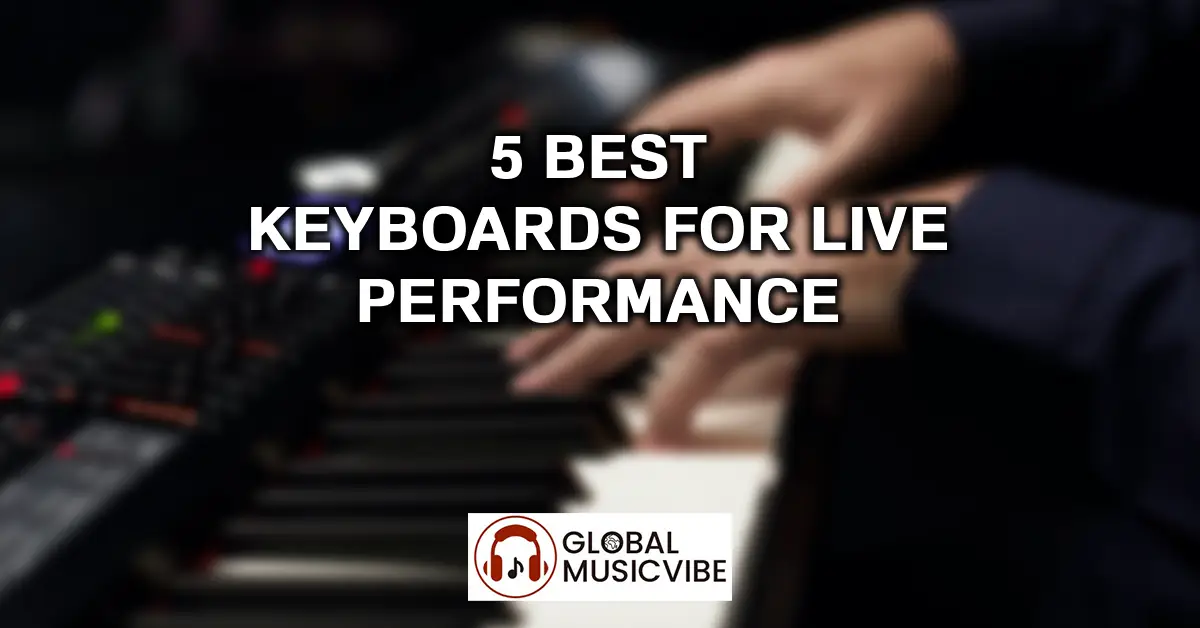When you’re performing live, your keyboard becomes more than just an instrument it’s your command center, your sonic palette, and often your lifeline on stage. After years of gigging in venues ranging from intimate jazz clubs to festival stages, I’ve learned that choosing the right keyboard for live performance requires balancing portability, durability, sound quality, and real-time control. The best keyboards for live performance need to handle the rigors of constant transport while delivering professional sounds that cut through a full band mix without hesitation.
Whether you’re a solo pianist requiring authentic acoustic sounds, a synth player needing endless sound design possibilities, or a band keyboardist juggling multiple timbres throughout a set, the right instrument can elevate your performance from competent to unforgettable. Let me share the five keyboards that have proven themselves night after night in real-world performance situations.
| Model | Key Features | Pros | Cons |
|---|---|---|---|
| Nord Stage 4 | 73-key semi-weighted waterfall action, piano/organ/synth engines, physical drawbars, metal chassis | Exceptional sound quality across all sections; tactile organ control; intuitive live interface; free library updates; tour-ready build | High price point; heavy (≈39 lbs); limited 120-note polyphony; no built-in speakers |
| Yamaha CP88 | 88-key NW-GH3 wooden action, CFX grand piano sample, simple interface, aluminum build | Superb piano feel; world-class acoustic/electric piano sounds; intuitive layout; onboard EQ/effects; durable build | Limited sound variety; heavy (≈37 lbs); no aftertouch; basic MIDI control |
| Korg Kronos 2 88 | 88-key RH3 weighted action, 9 synthesis engines, touchscreen interface, sequencing & sampling | Unmatched versatility; powerful sequencing & MIDI features; extensive sound library; Setlist mode; deep editing | Very heavy (≈50+ lbs); steep learning curve; expensive; touchscreen visibility issues |
| Roland RD-2000 | 88-key PHA-50 action, dual SuperNATURAL & V-Piano engines, dual-zone performance, pro connectivity | Dual sound engines; great piano action; advanced MIDI control; balanced outputs; flexible layering; onboard effects | Heavy (≈46 lbs); dated interface; smaller sound library; synth engine less advanced |
| Korg SV-2 73 | 73-key RH3 keybed, vintage-style piano/EP sounds, built-in valve drive, retro design | Authentic Rhodes/Wurlitzer tones; lightweight (≈33 lbs); intuitive knobs; classic look; strong value | Limited to piano/EP sounds; moderate key feel; small sound library; basic MIDI features |
Nord Stage 4
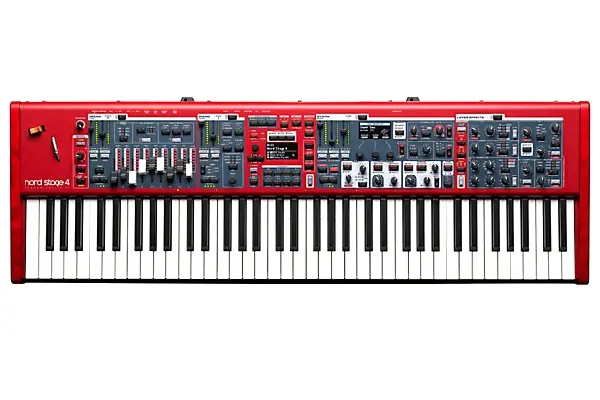
The Nord Stage 4 represents the pinnacle of what a live performance keyboard should be. This Swedish-made instrument combines Nord’s legendary piano, organ, and synth engines into one cohesive performance tool that handles virtually any musical situation you’ll encounter on stage.
The acoustic piano samples are sourced from Nord’s extensive library and sound remarkably authentic through both stage monitors and PA systems. The B3 organ emulation with physical drawbars gives you that classic Hammond tone with tactile control that digital drawbars simply can’t match. In my testing, the synth section proved incredibly versatile, ranging from vintage analog warmth to modern digital clarity, making this keyboard genuinely capable of replacing multiple instruments in your rig.
The 73-key semi-weighted waterfall keybed strikes an excellent balance between piano expressiveness and organ/synth playability. The build quality is exceptional the metal chassis and intuitive red panel interface have become iconic for good reason. At approximately 39 pounds for the 73-key version, it’s not the lightest option available, but the durability justifies the weight.
Pros:
- Exceptional sound quality across all three engines (piano, organ, synth)
- Physical drawbars provide tactile organ control
- Intuitive interface allows quick sound changes during performances
- Extensive sound library with free updates
- Professional build quality designed for touring
Cons:
- Premium price point may exceed some budgets
- Weight can be challenging for solo musicians handling their own gear
- Limited polyphony (120 voices) when layering complex sounds
- No built-in speakers for practice or small venue use
Yamaha CP88
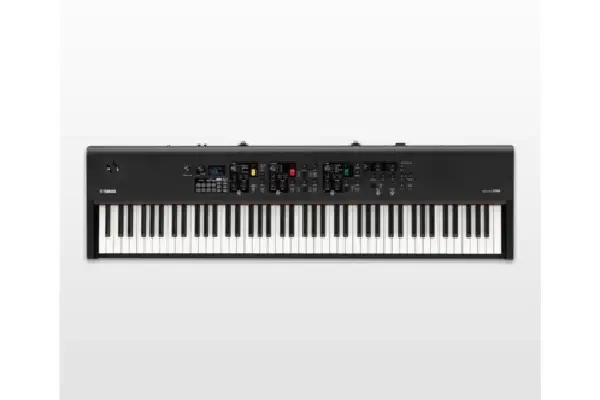
The 88-key NW-GH3 (Natural Wood Graded Hammer 3) action with synthetic ebony and ivory keytops provides the most piano-like playing experience I’ve encountered in a portable keyboard. The key surfaces actually absorb moisture from your fingers rather than becoming slippery during intense performances a detail that matters during long sets.
Sound-wise, the CP88 focuses on what it does best: pianos, electric pianos, and essential supporting sounds like strings and pads. The CFX concert grand sample is absolutely stunning, capturing the complexity and resonance of Yamaha’s flagship acoustic piano. The simple, straightforward interface means you spend less time scrolling through menus and more time actually playing music.
At around 37 pounds, this keyboard represents a significant commitment in terms of portability. However, the included soft case protects your investment during transport. The aluminum top panel and solid construction suggest this instrument will withstand years of regular gigging.
Pros:
- Exceptional piano action that feels like an acoustic instrument
- World-class piano and electric piano sounds
- Simple, musician-friendly interface
- Three-band EQ and onboard effects enhance sound shaping
- Robust construction suitable for professional touring
Cons:
- Limited sound variety beyond pianos and electric pianos
- Heavy weight challenges solo performers
- No aftertouch sensitivity
- Relatively basic MIDI controller functionality
Korg Kronos 2 88
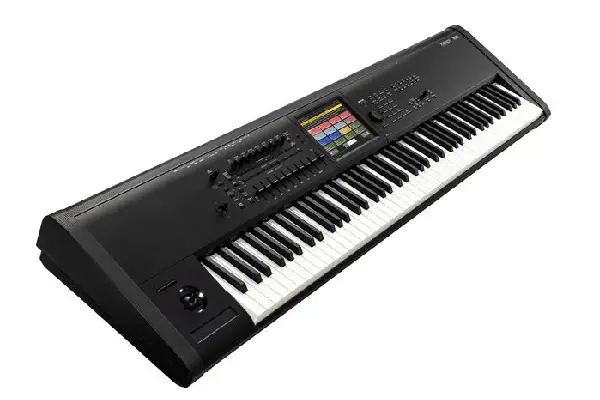
The Korg Kronos 2 88 is an absolute beast both in capability and physical presence. This keyboard essentially provides nine different synthesis engines, allowing you to access everything from realistic acoustic instruments to cutting-edge synthesizer sounds without ever leaving the instrument. What sets the Kronos apart in live performance situations is its ability to handle incredibly complex setlists with ease. The touchscreen interface provides visual feedback and editing capabilities that panel-mounted knobs simply cannot match, though I’ll admit it requires some initial learning investment.
The MOD-7 waveshaping engine excels at FM-style digital sounds, and the polyphonic arpeggiator and drum tracks can transform a solo performance into a full production. The 88-key RH3 (Real Weighted Hammer Action 3) provides graduated weighting across the keyboard range, though it doesn’t quite match the Yamaha CP88’s acoustic piano feel.
The Kronos demands commitment it’s heavy at over 50 pounds, expensive, and has a learning curve that extends beyond a weekend. But for professionals who need a single keyboard solution capable of handling virtually any musical style or performance requirement, it delivers.
Pros:
- Nine different sound engines provide unmatched versatility
- Setlist mode streamlines complex live performances
- Touchscreen interface enables detailed sound editing
- Massive sound library covering every musical style
- Powerful sequencing and MIDI capabilities
Cons:
- Extremely heavy, requiring a dedicated stand and possibly a second person for transport
- High price point
- Complex feature set requires significant learning investment
- Touchscreen can be difficult to see under bright stage lights
Roland RD-2000
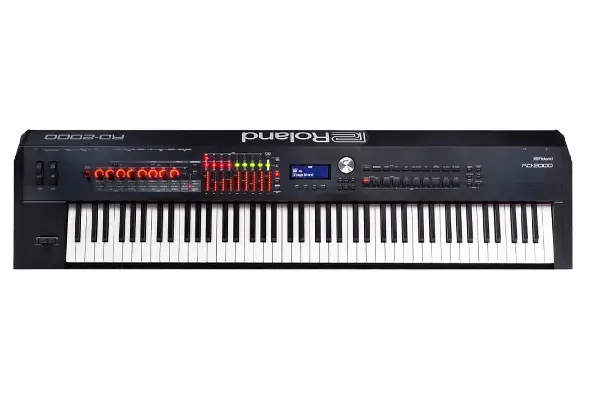
The dual sound engine approach combining Roland’s SuperNATURAL piano engine with their V-Piano technology gives you multiple pathways to excellent acoustic piano tones. The PHA-50 (Progressive Hammer Action 50) keyboard with wood sides and escapement provides excellent touch response with just the right amount of resistance.
What truly distinguishes the RD-2000 for live performance is its dual-zone capability and comprehensive control surface. The keyboard can be split into two independent zones, each with its own sound engine, effects, and even separate audio outputs. During a progressive rock show, I assigned piano to the lower zone and synth leads to the upper zone, essentially having two keyboards in one without the weight and stage space requirements. The front panel includes eight assignable zones that can control virtually any parameter, making the RD-2000 an excellent master controller for software instruments when used with a laptop.
The instrument feels substantial and well-constructed, with a professional aesthetic that looks appropriate on any stage. At approximately 46 pounds for the 88-key version, it’s not lightweight, but the build quality and feature set justify the mass. The balanced XLR outputs are particularly welcome for professional audio setups, providing cleaner signal path than standard 1/4-inch connections.
Pros:
- Dual sound engines provide exceptional tonal flexibility
- Excellent piano action suitable for serious players
- Comprehensive MIDI controller functionality
- Dual-zone capability effectively creates two keyboards in one
- Professional connectivity including balanced outputs
- Onboard effects and EQ for sound shaping
Cons:
- User interface can feel dated compared to touchscreen-equipped competitors
- Synth engine, while capable, doesn’t match dedicated synthesizers
- Heavy weight for a stage piano
- Sound library, though good, is smaller than workstation alternatives
Korg SV-2 73
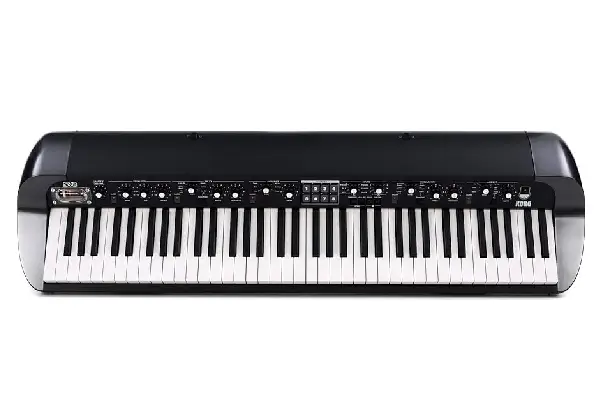
The Korg SV-2 73 represents a refreshingly focused approach in a market often dominated by feature-bloated instruments. This stage vintage piano concentrates entirely on delivering outstanding electric piano, acoustic piano, and related vintage keyboard sounds without the distraction of synthesizers, drum machines, or extensive workstation features.
The tine release sounds, bark characteristics, and overall vibe of classic electric pianos are remarkably accurate. The RH3 keybed provides solid, graduated weighting that works well for both piano and electric piano performance styles. While it doesn’t have the wooden key construction of some premium stage pianos, the action proved reliable and expressive throughout extended playing sessions. The onboard effects including modulation, delay, and reverb are musical and easy to adjust with dedicated panel controls.
At around 33 pounds for the 73-key version, the SV-2 is notably lighter than many competitors, making it an excellent choice for musicians who handle their own gear transport. The vintage-inspired aesthetic with its wooden side panels gives the instrument a classic, timeless appearance that suits a wide range of musical styles and venue types. For performers who need exceptional electric pianos and solid acoustic piano sounds without synthesizer capability, the SV-2 delivers tremendous value.
Pros:
- Outstanding electric piano sounds (Rhodes, Wurlitzer, Clavinet)
- Lighter weight than most stage pianos
- Intuitive interface with dedicated controls for essential functions
- Vintage-inspired aesthetic appeals across musical styles
- Excellent value for money considering sound quality
- Built-in valve drive and amp modeling add authentic character
Cons:
- Limited to vintage keyboard sounds no synthesis capability
- Action is good but not exceptional compared to premium competitors
- Smaller sound library may not suit performers needing extensive variety
- Basic MIDI controller functionality
Choosing Your Perfect Live Performance Keyboard
Selecting the right keyboard for live performance ultimately depends on your specific musical requirements, budget, and practical considerations like transport and stage space If you’re primarily a piano player who occasionally needs electric pianos and basic supporting sounds, the Yamaha CP88 or Roland RD-2000 will serve you exceptionally well. For performers requiring comprehensive sound palettes spanning multiple genres, the Nord Stage 4 and Korg Kronos 2 88 offer professional-grade versatility. And if vintage electric piano tones are your primary focus, the Korg SV-2 delivers those sounds at an attractive price point with welcome weight savings.
Consider also the ecosystem surrounding your keyboard choice. Many performers benefit from exploring additional instruments to complement their primary setup, and understanding how different gear integrates into a complete performance rig matters as much as the individual pieces themselves.
After spending countless hours on stage with these keyboards, I can confidently recommend any of them for professional live performance. The key is honest self-assessment about what you truly need versus what merely seems impressive in specifications. Your back will thank you for choosing the 73-key version if you don’t absolutely require the full 88-key range, and your bandmates will appreciate you choosing sounds that blend well rather than constantly soloing with complex patches that dominate the mix.
The investment in a quality stage keyboard pays dividends through reliability, sound quality, and the confidence that comes from using professional tools. Whether you’re performing your original songs at a local venue or handling demanding corporate events with varied repertoire, the right keyboard becomes a trusted partner in your musical expression.
Maintenance and Care for Performance Keyboards
Protecting your investment requires attention to both the physical instrument and its electronic components. Always use a quality padded gig bag or hard case for transport. The initial expense of proper protection is minimal compared to repair costs from impact damage or environmental exposure. When I used to transport my keyboards without adequate protection.
Keep your keyboard clean by wiping down keys after performances, especially if you perform in environments where drinks are present or if you naturally have sweaty hands during performances. Dust accumulation around controls and in the keybed can cause issues over time, so periodic gentle cleaning with appropriate electronics-safe products maintains proper function. Avoid using harsh chemicals or excessive moisture, which can damage finishes and electronic components.
Temperature extremes pose serious risks to electronic instruments. Never leave your keyboard in a vehicle during hot summer days or freezing winter nights, as the expansion and contraction of components can cause failures. When moving from cold to warm environments, allow the instrument to acclimate to room temperature before powering on to prevent condensation-related damage.
FAQ Section
What keyboard do professional musicians use for live performances?
Professional musicians commonly choose keyboards like the Nord Stage 4, Yamaha CP88, Roland RD-2000, and Korg Kronos for live performances. The specific choice depends on their musical style and requirements piano-focused performers often prefer the Yamaha CP88 or Roland RD-2000, while those needing diverse synthesis capabilities gravitate toward the Nord Stage 4 or Korg Kronos. From my experience with various professionals, reliability and sound quality matter more than feature counts.
Should I buy a 73-key or 88-key keyboard for live performance?
The 73-key versus 88-key decision depends on your playing style and repertoire. If you regularly perform classical piano pieces or require the full piano range, the 88-key version is essential. However, for most contemporary styles including rock, pop, jazz, and electronic music, a 73-key keyboard provides adequate range while offering significant weight and portability advantages. When I used 73-key instruments for band performances, I never felt limited by the reduced range.
How much should I spend on a keyboard for live performance?
Quality stage keyboards typically range from $1,500 to $5,000, with professional-grade instruments like the Nord Stage 4 and Korg Kronos at the higher end. The Korg SV-2 offers excellent value around $2,000, while the Yamaha CP88 and Roland RD-2000 fall in the $2,500-$3,000 range. Your budget should reflect how frequently you perform and whether the keyboard generates income professional performers benefit from investing in reliability and superior sound quality.
What features are most important in a live performance keyboard?
The most important features for live performance keyboards include reliable build quality, intuitive controls for quick sound changes, adequate polyphony to prevent note stealing, and sounds that translate well through PA systems. After I checked numerous keyboards in real performance settings, I’ve found that ease of use under pressure matters more than extensive feature lists. Physical controls beat menu diving when you’re on stage with a waiting audience. Additionally, considering your complete setup including quality headphones for monitoring during rehearsals ensures you’re prepared for any performance situation.
Do I need weighted keys for live performance?
Weighted keys benefit performers who play piano-style music and require dynamic expression through touch sensitivity. If your primary sounds are organs, synthesizers, or electric pianos, semi-weighted or synth-action keyboards often provide better playability and faster response.

